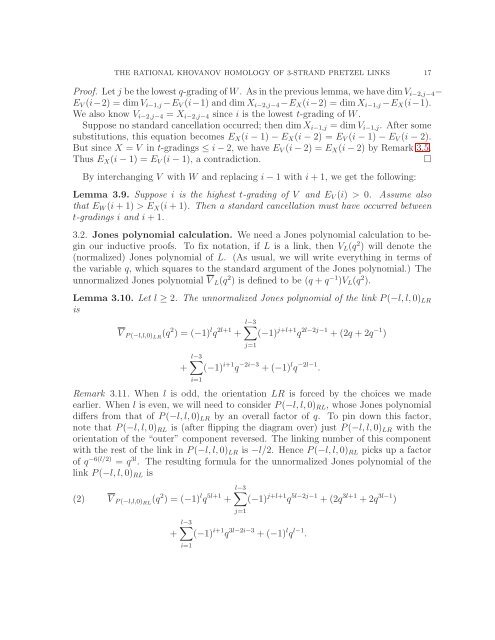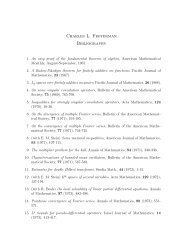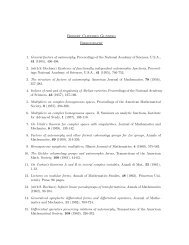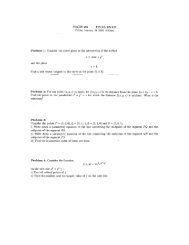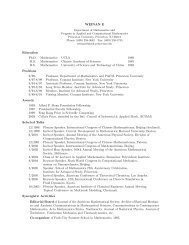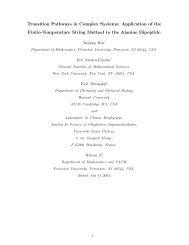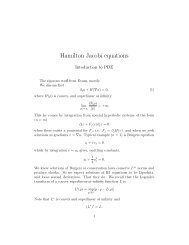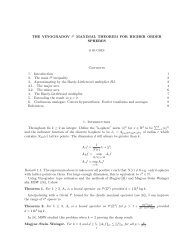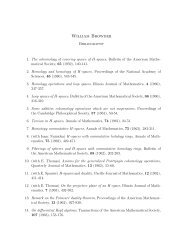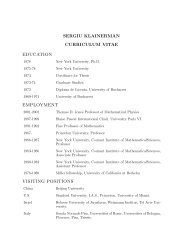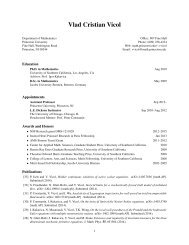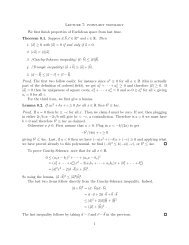The rational Khovanov homology of 3-strand pretzel links
The rational Khovanov homology of 3-strand pretzel links
The rational Khovanov homology of 3-strand pretzel links
Create successful ePaper yourself
Turn your PDF publications into a flip-book with our unique Google optimized e-Paper software.
THE RATIONAL KHOVANOV HOMOLOGY OF 3-STRAND PRETZEL LINKS 17<br />
Pro<strong>of</strong>. Let j be the lowest q-grading <strong>of</strong> W. As in the previous lemma, we have dimV i−2,j−4 −<br />
E V (i−2) = dimV i−1,j −E V (i−1) and dimX i−2,j−4 −E X (i−2) = dimX i−1,j −E X (i−1).<br />
We also know V i−2,j−4 = X i−2,j−4 since i is the lowest t-grading <strong>of</strong> W.<br />
Suppose no standard cancellation occurred; then dimX i−1,j = dimV i−1,j . After some<br />
substitutions, this equation becomes E X (i − 1) − E X (i − 2) = E V (i − 1) − E V (i − 2).<br />
But since X = V in t-gradings ≤ i − 2, we have E V (i − 2) = E X (i − 2) by Remark 3.5.<br />
Thus E X (i − 1) = E V (i − 1), a contradiction.<br />
□<br />
By interchanging V with W and replacing i − 1 with i + 1, we get the following:<br />
Lemma 3.9. Suppose i is the highest t-grading <strong>of</strong> V and E V (i) > 0. Assume also<br />
that E W (i + 1) > E X (i + 1). <strong>The</strong>n a standard cancellation must have occurred between<br />
t-gradings i and i + 1.<br />
3.2. Jones polynomial calculation. We need a Jones polynomial calculation to begin<br />
our inductive pro<strong>of</strong>s. To fix notation, if L is a link, then V L (q 2 ) will denote the<br />
(normalized) Jones polynomial <strong>of</strong> L. (As usual, we will write everything in terms <strong>of</strong><br />
the variable q, which squares to the standard argument <strong>of</strong> the Jones polynomial.) <strong>The</strong><br />
unnormalized Jones polynomial V L (q 2 ) is defined to be (q + q −1 )V L (q 2 ).<br />
Lemma 3.10. Let l ≥ 2. <strong>The</strong> unnormalized Jones polynomial <strong>of</strong> the link P(−l,l, 0) LR<br />
is<br />
∑l−3<br />
V P(−l,l,0)LR (q 2 ) = (−1) l q 2l+1 + (−1) j+l+1 q 2l−2j−1 + (2q + 2q −1 )<br />
j=1<br />
∑l−3<br />
+ (−1) i+1 q −2i−3 + (−1) l q −2l−1 .<br />
i=1<br />
Remark 3.11. When l is odd, the orientation LR is forced by the choices we made<br />
earlier. When l is even, we will need to consider P(−l,l, 0) RL , whose Jones polynomial<br />
differs from that <strong>of</strong> P(−l,l, 0) LR by an overall factor <strong>of</strong> q. To pin down this factor,<br />
note that P(−l,l, 0) RL is (after flipping the diagram over) just P(−l,l, 0) LR with the<br />
orientation <strong>of</strong> the “outer” component reversed. <strong>The</strong> linking number <strong>of</strong> this component<br />
with the rest <strong>of</strong> the link in P(−l,l, 0) LR is −l/2. Hence P(−l,l, 0) RL picks up a factor<br />
<strong>of</strong> q −6(l/2) = q 3l . <strong>The</strong> resulting formula for the unnormalized Jones polynomial <strong>of</strong> the<br />
link P(−l,l, 0) RL is<br />
(2)<br />
∑l−3<br />
V P(−l,l,0)RL (q 2 ) = (−1) l q 5l+1 + (−1) j+l+1 q 5l−2j−1 + (2q 3l+1 + 2q 3l−1 )<br />
j=1<br />
∑l−3<br />
+ (−1) i+1 q 3l−2i−3 + (−1) l q l−1 .<br />
i=1


